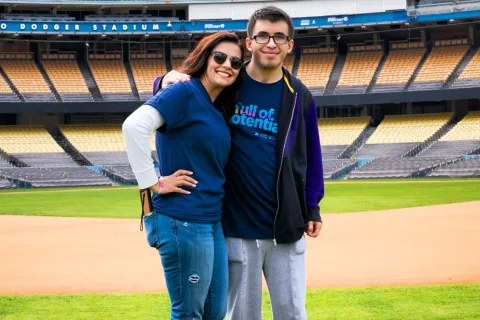Holiday safety plan
Preventing meltdowns, wanderings and accidents
By Irene van der ZandeTips to maximize your comfort while out and about during the holiday season
To have the most fun and prevent problems with your autistic loved one during the hustle and bustle of the holidays, it is best to put a clear, realistic safety plan in place before you venture out onto the city sidewalks, busy sidewalks.
Do less
Avoid stress by making decisions based on what is best for your family rather than on the expectations of others. Simplify holiday meals, gift-giving and social gatherings. Instead of hurrying, slow down – drive more carefully, take more time for transitions, and prepare everyone.
Get ready
Before you leave home, review the plan of what is going to happen and not happen in terms that make sense for your family. Anticipate potential temptations and triggers. Be realistic about crowded stores, impatient shoppers, distracted drivers, and long lines.
For verbal children, you might say: “Today we are going to visit three new stores at the mall to get presents and look at the decorations. We might have to park far away if the parking lot is full. Some drivers are not paying good attention so we will hold hands. If there are long lines and lots of people, we will be patient and wait. We can tell stories while we are waiting. We are not going to visit the pet store today to look at the kittens, but we can do that next month when things are quieter. We are not going to visit the ice cream store today, but we can have a cookie when we get home. We are not going to buy presents for ourselves today, but we can ‘bookmark' in our minds if there is a present you might like to have someday. There will be lots of lights and noises. It will be interesting and fun. We will stay together and we will check first before we change our plan.”
For less verbal children, review key safety rules in simple terms: Stay together. Check first. Stop and wait.
If a family member with special needs requires constant supervision, be sure to be clear about any handoffs in terms of who will be supervising, when, and where. For example, “While I am trying on clothes, Maria will stay with Josephine and we will agree on a fun place to wait, such as the mirrors.”
Review the safety plan in case someone gets separated or lost. Have your mobile phone number on your child’s arm or a card. Take a photo with your cell phone. Practice how to wait and how to ask for help.
Remind, watch, intervene and redirect
When you arrive, review the plan or ask your child to repeat this back to you. At each new location, review what to do in case you get lost or separated – where to wait, who to ask for help, etc.
Split your attention so you can stay aware of what your child is doing all the time. Keep them next to you to avoid trouble. Remember that a child can get hurt, disappear, or do something unsafe in an instant. Be very consistent in intervening to stop unsafe behavior.
If something unexpected happens, stick with your plan unless it is an emergency. For example, if you run into a friend, avoid socializing unless that was part of your plan. Adult socializing can cause kids to get tired, frustrated and to feel as if the plan isn’t actually real. Instead, you can keep moving and say, “It’s so nice to see you. I can’t stop to chat right now because I promised Christopher that we would stick with our shopping plan. Have a great day!”
Redirect wishes with compassion and humor. For example if a child is tired, you might sit on a bench and watch for a few minutes. Or you might say, “I wish I were an elephant and could carry everyone.”
Celebrate
At the end of each trip, review what went right. Congratulate family members on what they did to make this trip fun. Give a reward for a job well done. If something went wrong, discuss this at a different time, before you go out again. Remember and express to your family that things don’t have to be perfect to be great.
Additional resources:
- Safety Plans for Families With Special Needs
- Kidpower Safety Signs
- Unlimited Adaptablity
- “What If I get Lost?”
- A Five Step Plan For Preparing Your Child for More Independence
Irene van der Zande is the founder and executive director of Kidpower. She has extensive experience in teaching safety skills to people of all ages and all levels of autism. Kidpower was previously awarded a grant from Autism Speaks to increase the access and relevance of their “People Safety” curriculum for this community.








